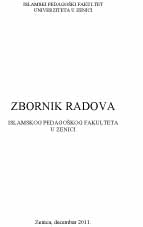KRATKA ANALIZA SUBJEKATSKIH I NESUBJEKATSKIH WH-PITANJA U ENGLESKOM JEZIKU U OKVIRIMA ANALIZE PF STAPANJA
BRIEF ANALYSIS OF SUBJECT AND NON-SUBJECT WHQUESTIONS IN THE ENGLISH LANGUAGE UNDER PF MERGER ANALYSIS
Author(s): Amna Brdarević-ČeljoSubject(s): Education
Published by: Islamski pedagoški fakultet Univerziteta u Zenici
Keywords: wh-questions; wh-movement; head movement (T-to-C movement); [wh] feature; [EPP] feature; [TNS] feature; PF-merger under adjacency analysis
Summary/Abstract: In generative grammar, questions with wh-question word in the English language are usually named wh-questions, because all wh-words, with the exception of ‘how’, begin with consonants ‘wh’ in written English. However, a further distinction needs to be made between wh-questions in which wh-word has the grammatical function of being the subject and those in which whword fulfils the grammatical function of object or adjunct, i.e. subject and non-subject wh-questions. It is important to draw this distinction in every in-depth analysis of wh-questions in English, because the structure of these two types of wh-questions differs significantly. This difference is especially noticeable when only the main (lexical) verb is used in their formation, i.e. in auxiliariless questions. In that case, in the formation of non-subject whquestions the DO-support operation has to be applied and the auxiliary verb DO is used to support the stranded affix, while in the formation of subject wh-questions DO is not inserted into the structure and inflectional suffixes are lowered onto the main verb (Affix lowering). This essential difference in the structure of subject and nonsubject wh-questions shows that non-subject questions necessarily involve T-to-C movement operation of verbal element, while subject wh-questions do not. This raises the important question as to whether subject questions are CP-projections like non-subject wh-questions or whether they only project as high as TP. With respect to that, in the first two sections of this paper we carry out a comparative analysis of subject and non-subject wh-questions in English and briefly outline different approaches to the study of subject question structure and their deficiencies. In the concluding section of the paper we try to offer a new and comprehensive solution for the asymmetry in T-to-C movement in these subtypes of wh-questions in English by applying the PF-merger under adjacency analysis.
Journal: Zbornik radova Islamskog pedagoškog fakulteta u Zenici
- Issue Year: 2011
- Issue No: 09
- Page Range: 239-260
- Page Count: 22
- Language: Bosnian

